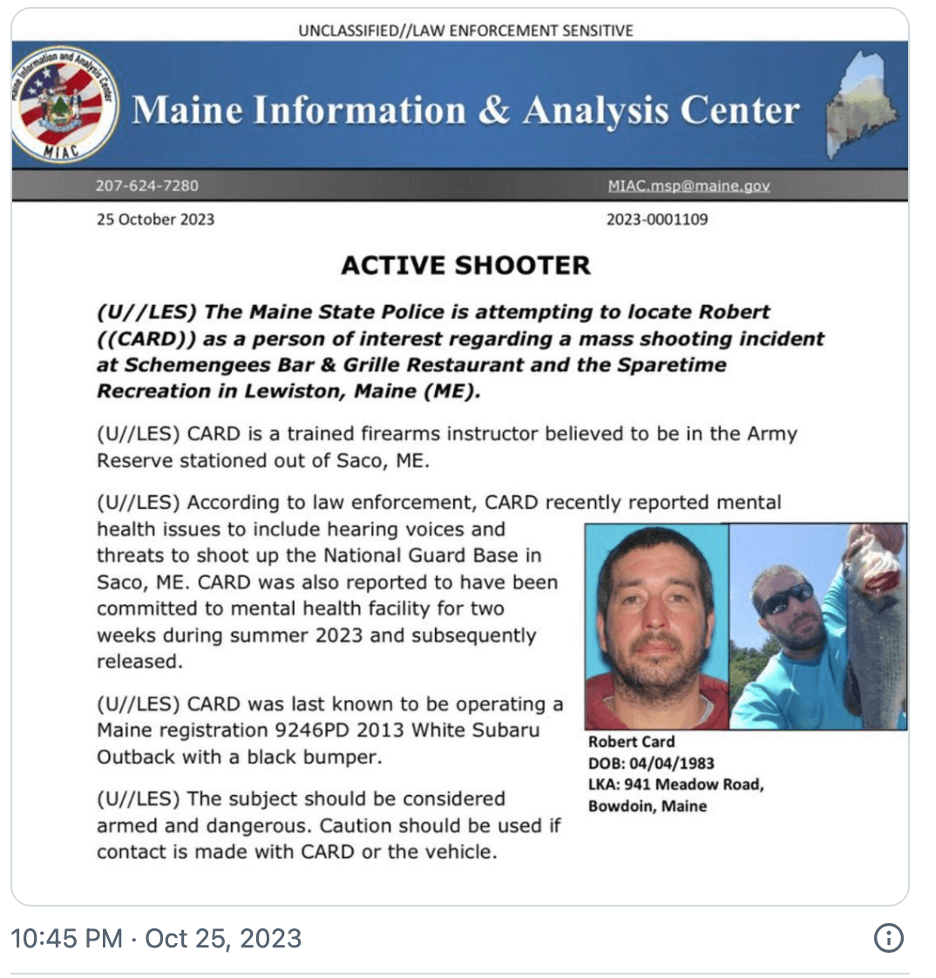Local television stations in Portland, Maine, became a vital source of information Wednesday night as police fanned across nearby Lewiston in a search for a man suspected of shooting dozens of people at a bowling alley and bar. Maine Gov. Janet Mills said in a press conference Thursday morning that 18 people had been killed and 13 more had been injured. A person of interest remained at large.
Late Wednesday night, WGME, a CBS affiliate, told viewers to stay indoors and delivered the news that schools in Lewiston will be closed Thursday.
ABC affiliate WMTW told viewers that even though cable news channels were reporting high fatality and injury figures, the station would only report what police confirmed.
And WCSH, an NBC affiliate, reported that police were gathered near a boat launch just before midnight while officers with rifles drawn checked every vehicle they encountered. Just after midnight, WSCH reported that a reunification site had been established to get families reliable information about their loved ones.
Local journalists shared unusually clear images of the shooter as he opened fire with an AR-15-style rifle.
At 10:40 p.m., the Bangor Daily News reported that police were looking for 40-year-old Robert Card II. The Lewiston Police Department called Card a “person of interest.”
CNN chief law enforcement and intelligence analyst John Miller reported that Card is “attached” to the Maine Army Reserve and is a firearm instructor with the military.
Miller quoted police as saying that Miller recently lost his job at a recycling center and was hospitalized in a mental health facility for two weeks this summer before being released. A police report said Card said he “had been hearing voices” and that he had threatened to shoot up the National Guard Center in Saco, Maine.

(Maine Information and Analysis Center)
Maine has “very few” gun safety laws, according to Everytown, a gun violence research center. In Maine, 89% of gun deaths are cases of suicide.
Card’s hospitalization for mental health issues may become a topic of future investigation since Maine prohibits people who have serious mental illnesses from owning a firearm.
Everytown explained:
These policies prohibit gun possession by people who have been involuntarily committed to a psychiatric hospital or found to be a danger to themselves or others due to mental illness. While federal law already bars these individuals from having guns, a separate state prohibition is important to ensure the law is enforced properly. Most states offer a form of petition process for restoring gun rights when a person no longer poses a danger.
While semi-automatic, AR-15-style rifles are often mentioned during the coverage of mass killings, more people are killed with handguns than those weapons, even in mass shootings, according to Statista.
Statista’s data also shows that white men account for most mass killings.
This is the 565th mass shooting in the U.S. this year, Gun Violence Archive data show. More than 35,000 people have died in gun violence in 2023, and more than half of them were suicide deaths, Gun Violence Archive shows. The Trace, a newsroom dedicated to covering gun violence, reported, “At this rate, we could surpass last year’s toll of 645 mass shootings, the second-highest total on record.”
The Trace analysis looked at data from all 50 states and the District of Columbia and found:
Illinois had the most mass shootings over the 10-year period (435), followed by California (406), Texas (281), and Florida (251).
The District of Columbia, Louisiana, Illinois, and Mississippi had the highest rates of mass shootings.
Only two states — Hawaii and North Dakota — recorded no mass shootings at all over the 10-year period we analyzed.
Texas, a permitless carry state with no background check requirement, recorded more mass gun murders than any other state (32); California, with a population larger than Texas’, recorded 24.
Just eight states experienced no mass murders from 2013 to 2022.
Mass shootings account for less than 5 percent of the nation’s gun violence toll. But the data suggests that over the years, daily shootings have grown to include more victims, turning what were once low-casualty incidents into mass shootings.
This article was updated to include the number of deaths as confirmed by Maine’s governor and to correct that WGME is a CBS affiliate











